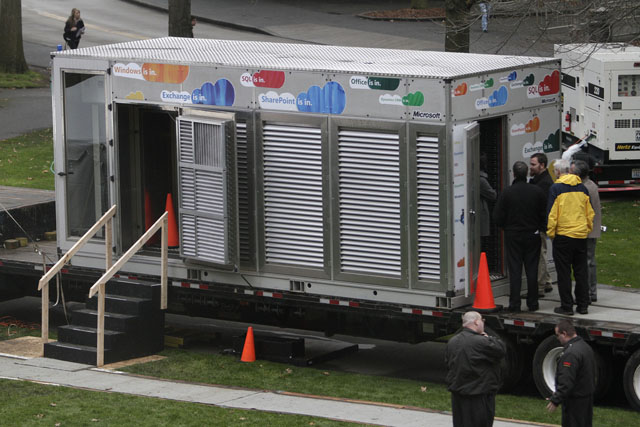My PAC's better than your POD. Or is it?

Last week, in his keynote speech at the DataCenterDynamics conference in NYC, Microsoft's Global Foundation Services head Kevin Timmons announced details about the IT PACS (datacenter pods to the rest of the datacenter world, "Pre Assembled Components" to Microsoft) they will be building and selling. The following day, Steve Ballmer gives his speech on Microsoft's cloud computing plans, using pre-production pods as a backdrop. So it looks like Microsoft is taking a running leap at one of the hottest concepts being pushed in the datacenter world.
If the security guard needs a rain slicker, isn't having a louvered pod full of hardware outdoors a bad idea?This doesn't exactly come as a huge surprise; in June of 2008, Danny Costello, Microsoft's Director of Datacenter Research, said "The idea of modular, portable data centers is the key to the industry's future." So clearly, Microsoft has been planning this for quite a while. Anyone who has attended a major Microsoft event, such as Tech-Ed or WinHEC, may have also encountered the container-based datacenters that Microsoft has been building for their own use.
Pod technology isn't new, and companies like HP have already released multiple generations of pod technologies (Larry Dignan covered last month's release of the new, smaller, HP pod.)
And frankly, my first thought when looking over the various Microsoft announcements, speeches, and press materials that talked about the pods, directly or indirectly, was to look at this picture from Microsoft and think "if the security guard needs a rain slicker, isn't having a louvered pod full of hardware outdoors a bad idea?"
But then I came upon Kevin Timmon's statement that the PUE of the pod, in testing, is 1.06. That, my friends, is a great power usage effectiveness number for a production datacenter environment. I've been doing a lot of research recently on building efficient datacenters, so that number really caught my attention. Fortunately, my natural cynicism came to the fore. PUE is a good metric, and the industry has been pretty good about adopting it and implementing it since its introduction in 2007 (more information about PUE can be found at The Green Grid), but - and it's a big but - we have to assume that Microsoft is accurately measuring and reporting on the energy being dumped into the pod, which will make the usual run-of the-mill Microsoft basher foam at the mouth.
As it is, I'm perfectly willing to accept the number. It is with the awareness, however, that the PUE they are achieving applies only to the specific equipment configuration and internal and external environmental control being applied when that measurement was taken. And beyond that, it's basically useless as a comparison to any other environment. Especially with mobile equipment such as a small PAC. Or pod. Whatever.
Having grown up with the computing industry and harking back to the days when FUD was an industry standard, I take a very jaundiced view of synthetic benchmarks being applied to complex systems. And while I consider PUE and its reciprocal number DCiE to be useful tools when designing and evaluating datacenter operations, having them bandied about as meaningful metrics for comparing operational efficiencies in a vacuum doesn't do the datacenter vendors any good.
